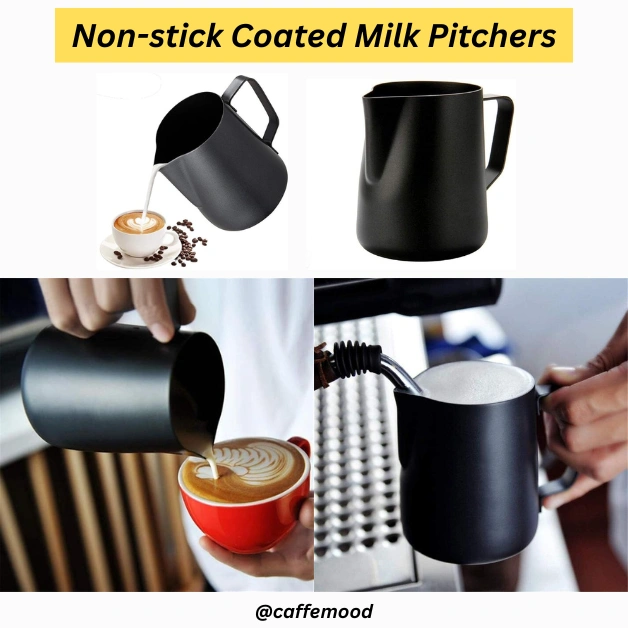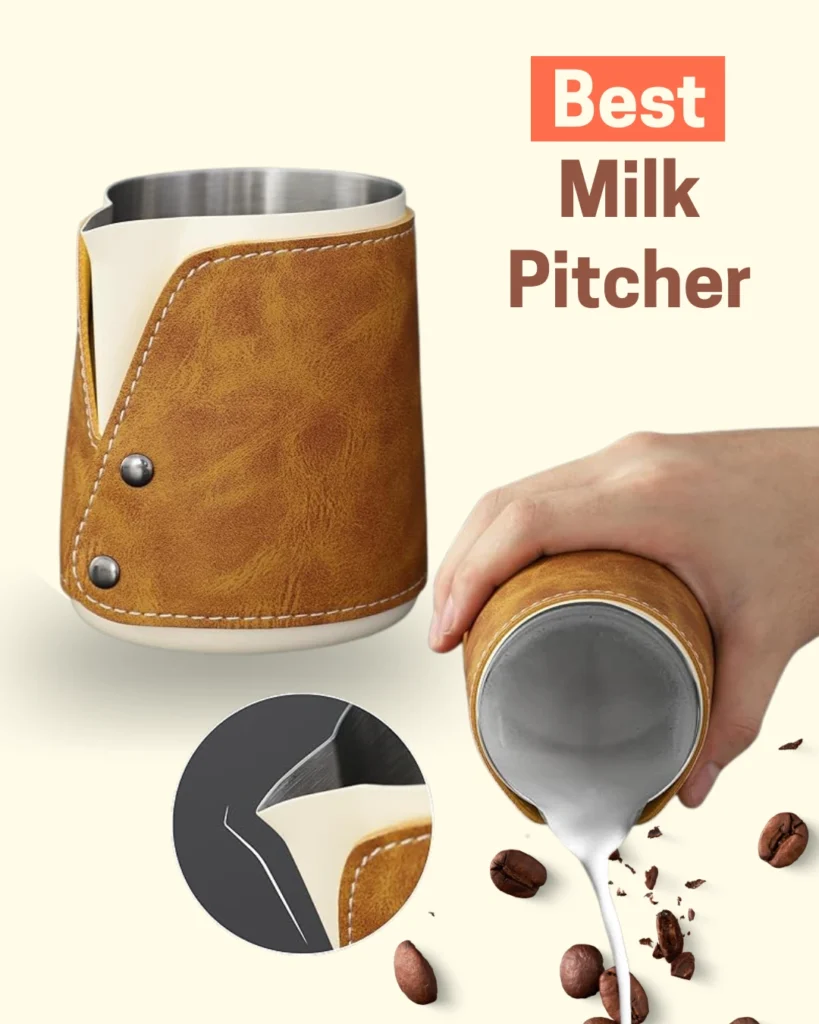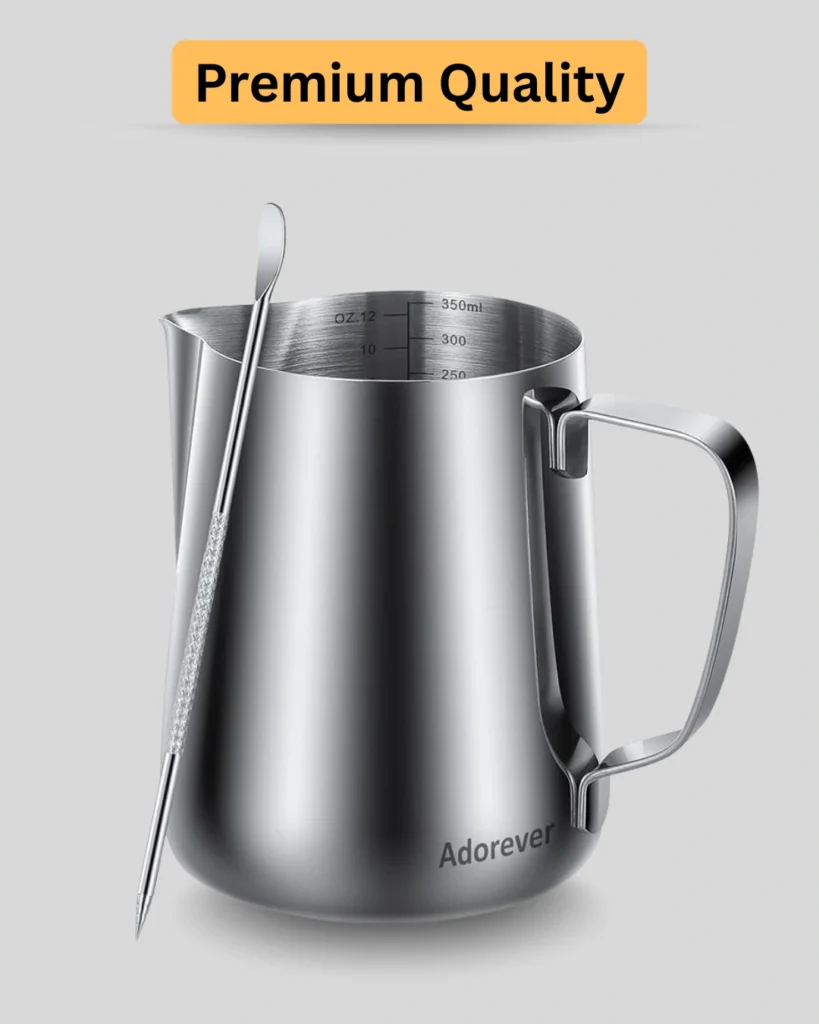Milk Pitcher Explained: Types, Sizes, and Features You Need to Know !

Table of Contents
Introduction to Milk Pitchers
What is a Milk Pitcher?
Milk pitcher is also called a frothing pitcher or steaming jug in the coffee world. It is highly efficient while making coffee, especially used in coffee shops. It’s the star behind the creamy cappuccino or a beautiful latte art by the baristas. Milk pitcher is designed especially for the coffee bar use and is one of the important coffee accessories that is most needed for every coffee bar user. Milk pitcher holds and steams the milk with the help of a coffee machine steam wand. It’s more than we think, its size, shape, nozzle and the quality can totally affect the coffee with their final presentation.
A well-crafted and designed milk pitcher allows air to coordinate with the milk and transform into thick and silky microforms that makes our drink like latte and cappuccino perfect with their standard. Achieving consistent perfect froth every time is impossible, whether you are a beginner making coffee at home or a pro barista in a busy cafe, milk pitcher is just made for making your milk texture fine.
The important note of the milk pitcher is that it is built and different sizes, material used, the quality and all of these aspects can hugely change the froth, steam and pouring of the milk. Mostly we can fine sizes vary especially to hold the volume of the milk.
Let’s go deep knowing about milk pitchers through this article, till the end you will be able to know the magic behind the perfect flow of milk, texture and how the baristas are able to art world class latte art with the help of milk pitchers. Also we are going to explore top milk pitcher lists through this article.
Why Every Coffee Lover Needs One ?
Did you ever try making latte art with the regular mug or bowl? Definitely the experience was not satisfying and you have ended with a mess. The milk pitcher is only the solution to craft beautiful steamed milk foam and the latte art or a cappuccino milk texture. The material used to design the pitcher holds up under high temperature and controls the heat over the milk by ensuring the milk doesn’t turn into a bubble without having any control. For the high quality pitcher usually stainless steel material is used on it.
Love to have coffee at your home? Pitchers are entirely game changers. You don’t have to stress yourself to run towards your nearby coffee shop for your regular, preferable coffee drink. It’s essential to have the right technique and the skills with experience of pitcher handling to create a barista-level coffee right at your home kitchen. If we discuss with the barista how they are able to make a perfect cappuccino or a latte then, it’s all about knowing the tools perfectly and how experienced you are at handling it. Most of them are milk pitchers.
Plus, let’s never ignore the beautiful and even wonderful side of things. Those swirly hearts and tulip patterns crafted on lattes and feeling admired on it? Of course, it’s all about the techniques and the precision devoted by the baristas while making coffee. A milk pitcher is a must, if you are a true fan of coffee.
Different Types of Milk Pitchers
Stainless Steel Milk Pitchers
Stainless milk pitchers are the first choice for all the baristas and coffee lovers. It’s a go-to-choice for a café and home kitchen. Because they’re perfectly crafted for resisting the high heat, durability, user-friendly and rust-resistant. They are designed in various finishes like mirror-polish, matte black, brushed steel and each and every one has their unique appearance and still gives you a satisfying result.
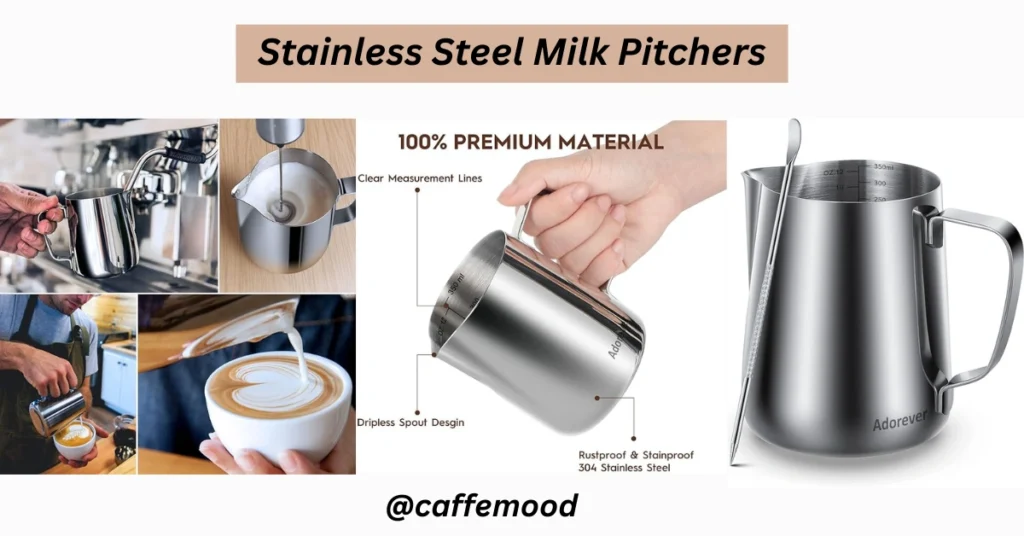
For temperature retention, thick and the stainless steel are the perfect one; they will give you the barista level coffee crafting feel. They can monitor the milk heat and give you the opportunity of controlling the temperature. You can feel the warmness of the milk even without a thermometer; feel the warmness touching the pitcher while steaming. (Especially recommended for beginners)
They are easy to clean. You can simply rinse and scrub and that’s it you are ready to go for the next pour. It even looks professional and perfectly crafted for a steam wand and easy to grab on your hand. If the milk jug is old, it can be washed and curbed to reuse it. If you are a beginner or a pro, a metal milk jug should be your first choice.
Non-stick Coated Milk Pitchers
We all hate the situation of facing burned milk. The solution of avoiding it is using non-stick coated milk pitchers which are non-sticky and have full control over temperature if known the procedure properly. These have stainless steel at the core and coated with non-stick Teflon or have ceramic layers inside and from outside as well.
They can be found in a variety of bold, sleek colors which are perfect for the baristas to match with their vibes. The condition: they require more care. No harsh scrub even using abrasive sponges because they can ruin the coating on it. If you see the coating starting to peel-off, it’s time to replace it.
They are perfect for personal use or for boutique style coffee shops where the presentation and the hygiene is the top priority. Just to be careful: treating carefully and gently as they will treat your milk well.
Glass and Ceramic Milk Pitchers
It doesn’t come in commonly used but visually stunning and attractive, glass and ceramic milk pitchers are not about the function. When it comes to steaming milk they are not ideal and less practical but ideal for serving milk or cream at the table. It’s not ideal for steaming, why? The glass can crack under rapid temperature changing as ceramic is built poorly at conducting heat evenly.
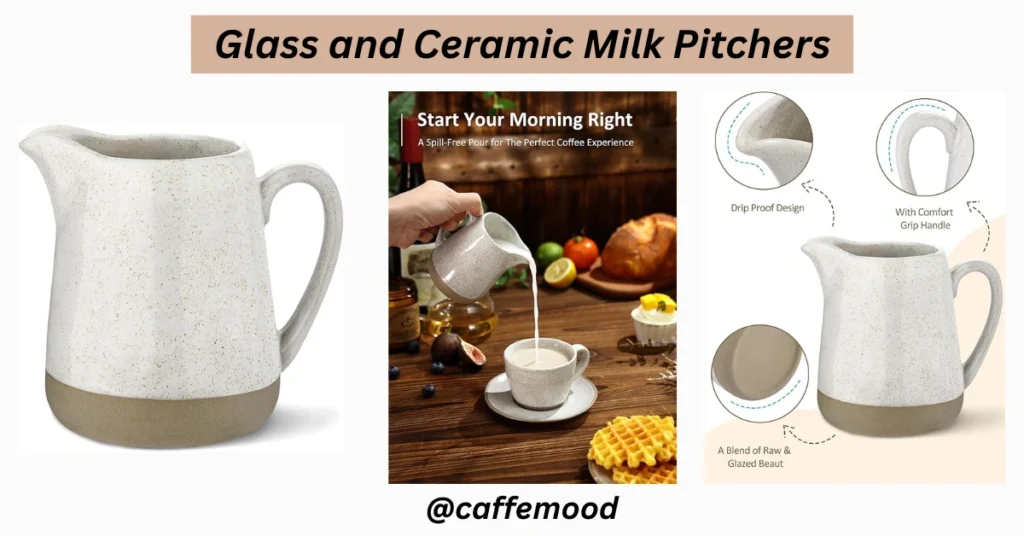
Presentation is everything when it comes to specialty cafes and home setups. Glass and ceramic milk pitchers are the star on it. Cold and warm milk can be poured easily; they make a great additional setup for your breakfast and overall setup.
For perfect milk steaming and impressing the guests coming to your home, this glass or ceramic pitcher in your collection will be the best choice.
Smart and Digital Milk Pitchers
Technology has taken over the world, and milk pitchers also are a part of the growing technology. Let’s welcome the future of the coffee world with smart milk pitchers and the digital equipment of making coffee. Smart milk pitchers come with a digital thermometer, Bluetooth connection and even weight sensor.
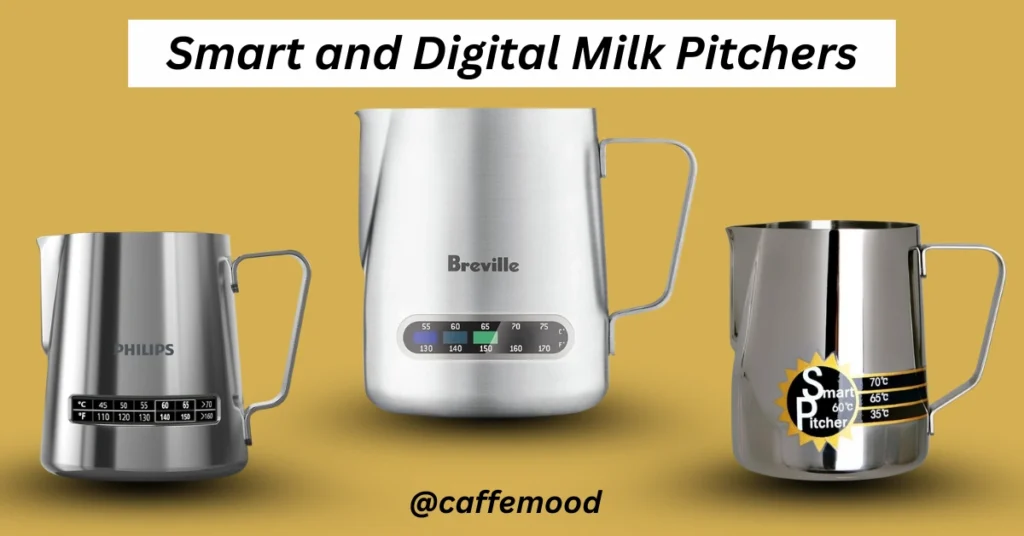
This tool is user-friendly especially in busy cafes and where the quality of coffee matters. Modern technology milk pitchers with a thermometer allows the baristas in controlling the temperature, reducing the risk of burning milk and resulting in ideal frothing of milk. Milk temperature is standardized around 150°F or 65°C; when it reaches its temperature on the limit it vibrates: only in modern technological pitchers.
They are not the regular pitchers that we can find in the local market, they are found at a high price and only with legitimate sellers. If you are looking for perfection this is the perfect choice and can grab the customer’s attention by how fast and standard coffee you are serving them. Just make sure you don’t mind having gadgets in your work flow.
Milk Pitcher Sizes and Their Purposes
Small (12 oz) Milk Pitchers
12 ounce pitchers are small pitchers which are suitable for steaming milk for a single cup of coffee. This size is perfect if you enjoy making a single cup of cappuccino or latte. It’s easy and comfortable for a single cup and you can even grade your coffee higher.
The key advantage of this pitcher is proper control over milk temperature, texture and easy handling by hand. The reduced volume of milk and making the perfect milk texture is helpful for latte art. The less time of steaming consumes the time and gives fast serving. Small size pitchers often help to ignore wastage of ingredients.
However, a small size pitcher is enjoyable and gives an ideal brew for one cup like, 12oz cup. If you are enjoying the coffee at your home this is the best one but if you are using it in a busy café shop it might affect fast service.
Medium (20 oz) Milk Pitchers
The 20 oz (600 ml) milk pitcher is commonly used in café even at home bars. It is favorite to the brewers because it can make 2 coffees at a single time. For 2 coffees for e.g. if you are making latte and cappuccino, it can be great help making them at single steam.
This pitcher gives perfect control over capacity and even makes milk texture. To practice advanced latte art this might be your great help. Pitchers are more easy to handle and steam desirable milk especially to the newly brewers.
The 20 oz size pitcher is the perfect size to enjoy and practice steaming milk. If you are a fan of coffee or a barista this will perfectly vibe to your brewing experience.
Large (32 oz or more) Milk Pitchers
Large milk pitchers are typically 32 oz (1 liter) or larger than that which are designed with high-volume serving especially busy and continuous coffee making cafes. They’re ideal in busy coffee shops where time and efficiency both matter a lot. With this pitcher one can easily steam milk for 3–5 drinks at a time, which is perfect for larger gathering customers.
While they offer a huge capacity of milk steaming, brewers need to learn how to handle it . The size of the pitcher matters in terms of handling it, and pouring perfect latte art will be more challenging. If your grip and control over the pitcher aren’t on point, you might end with wasting milk. They heat your milk slower, and maintaining the texture of milk might be difficult.
Still, if you’re managing a café with precision even in rush hours, hosting guests, or brewing coffee for a bunch for coffee lovers, this is the size that can help you out in that situation. Just be sure, your espresso machine’s steaming power can satisfy the milk on this pitcher.
How to Choose the Right Size for Your Needs?
So, which size should I try to get friends with? That depends entirely on how you plan to use your milk pitcher and the number of coffee you want to make with that pitcher. Here’s a quick guide to help check it out:
- Single serve at home – Go for a 12 oz pitcher.
- Brewing for two – Choose a 20 oz pitcher.
- Serving multiple drinks – Opt for 32 oz or larger pitchers.
Size is not always the challenge but how skilled you are, the space that is allowed by your espresso machine and what you want speed or control. Well, small pitchers are perfect and can be helpful for the beginner brewers and if you are a barista or skilled enough, the size doesn’t matter just how flexible you want in your work flow.
And remember, having more than one pitcher can be beneficial. Many baristas keep a 12 oz for practicing art, a 20 oz for everyday use, and a 32 oz for busy times. Variety, in this case, leads to mastery.
Having more than one pitcher is helpful. Mostly
- 12oz pitcher is for practicing latte art which are kept by baristas,
- 20 oz pitchers for the baristas and everyday use and
- 32 oz is for a busy café.
Key Features to Look for in a Milk Pitcher
Material and Durability
What matters most? Let’s explore: material. Mostly, quality milk pitchers are made of food-grade stainless steel and there is a good reason why it’s stainless steel. It’s strong, resists corrosion, and stands tough high temperature heat of steaming milk every time.
Best stainless steel provides better heat conductivity that can help you achieve exact temperature. This is most important because change and inconsistent heat can end up with poor texture of milk having wastage. The best grade of stainless steel comes from an 18/8 or 304-grade stainless steel pitcher which can give you a high performance level.
Let’s talk about other materials used to make pitchers; some of them are made of ceramic, glass or plastic composites. They are fine to use but can’t hold up in a situation of high heat. And in terms of long-term use and ideal, the first choice is always stainless steel.
Handle and Grip Design
Handles are the important part of the pitchers which should be designed as user-friend and easy to grip on. The poor design of the handle can grip out your steaming and lose control. The well-aligned and perfectly fitted handle on the pitcher can comfort your hand and can even help when the milk is extremely hot.
Some of the baristas prefer handleless pitchers for practicing advanced latte art, which can allow them control over the milk movements and observe temperature. But they are not for the beginner users.
Always test how the handle feels on your hand.
- Does it allow pouring the milk at different angles?
- Can you hold it easy and stable even when it’s full?
- Is it comfortable in both small and large hands?
These details matter more than just steaming the milk or griping the pitcher.
Pouring Spout – Precision and Control
Pouring spout let your latte art be perfect whether it’s a heart shape or Rosetta. This small impact shows the perfect control over milk flow in your cup.
There are typically two types of spouts:
- Round Spout: Best for simple pouring and general steaming.
- Sharp Spout: Ideal for latte art– more detailed lines and better control.
A sharp spout creates the best pouring even cutting through the espresso creams. Round spouts can be the beginners basic try.
The shape defines the speed of milk flows, essential for practice of latte art on how freely you can pour the milk. Spout is the first thing to keep in mind if you want to make an attractive latte art or any other designs through the milk foam.
Heat Retention and Distribution
How well does your pitcher handle the heat? The thickness of metal and perfectly designed build quality of your pitcher defines your milk temperature control without being overheated and steaming efficiently even cooling down quickly.
If the pitcher is very thin, you will end up with your hand burned or lose heat quickly, even the wastage of milk. If the pitcher is thick, it takes more time to heat up. Most baristas and the professionals, they choose a mid-weight pitcher which can allow you to get heated accordingly and feel the temperature change by touching it. (For new users recommended thermometer)
Some higher-end pitchers can be found with double-wall insulation for better heat retention and safer handling by the users. Not very essential however, it’s a bonus feature that adds value.
Benefits of Using a Milk Pitcher
For Home Baristas
If you are a coffee lover, making your daily coffee right in your kitchen, milk pitcher not just helps you in a single route: it’s transformational. It helps you to elevate your coffee game from basic to barista-level, which gives you full control over the temperature of milk, texture and the presentation. Choosing the right milk pitcher can impress your guests through the latte art.
The key point to keep in mind for baristas is consistency. A right milk pitcher allows the milk without bubbles or overheating without knowing. You will learn to produce micro-foam and silky, velvety milk which is essential for latte arts and even flat white coffee.
Milk pitchers are versatile. One can use the pitchers to steam milk, measure liquids, and store small amounts of cream and sauce. They are dishwasher safe and easy to clean,
Every user appreciates how a perfect pitcher helps build confidence. Steaming milk is somehow tricky when you try it for the first time, with the right tools and techniques you will learn it quickly. The pitcher is designed for job holders but let’s not forget it will end you making a flawless latte art.
For Coffee Shops and Professionals
In this technical and growing world, each and every second counts important especially in the coffee world, each and every cup needs to be perfect. In this case the milk pitcher came across a successful working tool. It’s a weapon of baristas to make your coffee perfect and well designed. To forth milk quickly, consistently and safely milk pitchers are the ideal.
For the professionals milk pitchers are designed in precision spouts, easy handles and balanced weight helping baristas to make the coffee fast and perfect even in the rush hours. The quality of the milk pitcher defines the milk temperature and its texture which affect the final touch of the coffee and you might lose your customer. It’s important to deliver the coffee with precision to your customers, if you want to make your customer return for their next coffee.
The choice of keeping multiple milk pitchers allows the professionals to separate the dairy and non-dairy milks to prevent the cross-contamination. Soya, almond, coconut and oat milk are commonly used and having multiple pitchers ensures proper taste and importantly allergen safety.
High quality milk pitchers and be used daily for years. Having it properly cared for even by the busy barista working in a busy café won’t need to be replaced. Investing in reliable pitchers and tools is the small detail that plays gig role in commercial business which can lead the successful café.
Maintenance and Cleaning Tips
Daily Cleaning Routine
Keeping the milk-pitcher clean all the time is the first priority and it’s non-negotiable. Dealing with milk which can turn sour anytime and there is a high chance that it can affect your next drink. The small habit can make your coffee fresh and drinkable all the time.
Rinse the pitcher after the use, use a soft sponge to scrub the leftover milk in the pitcher. Never leave the steamed milk in the pitcher because it dries fast and becomes a sticky mess. Use mild dish soap and warm water after having it rinsed to have a deeper clean.
Use a brush if your hand is not fitting inside. Make sure you reach the spout properly because sometimes dry milk on it is hardly noticeable, to avoid water spots or bacteria to grow rinse timely and air-dry it from upside down.
Always avoid metal scrubbers or harsh chemicals for the pitchers which are non-stick or coated. Soft sponge or microfiber cloth will be the perfect to use without having any damage on the pitcher.
Deep Cleaning Methods
Even with regular cleaning, milk pitchers need occasional deep cleaning to remove stubborn residue or smell. Here are a few effective methods:
Milk pitchers need occasional deep cleaning even regular cleaning practice to remove stubborn or smell. Here are the best methods to keep effective:
- Vinegar and Baking Soda: Mix equally white vinegar and water, and leave it together inside the pitcher for 10–15 minutes. Add a full spoon of baking soda then scrub gently and rinse thoroughly.
- Espresso Cleaner Tablets: Use a barista approved tablet to clean the pitcher. Drop the tablet in the pitcher and add hot water and leave it for 15minutes for soak then scrub and rinse.
- Dishwasher: If the pitcher is labeled dishwasher-safe then it’s ok to use. However, the hand washing the pitcher usually extends its life, especially for non-stick or painted models.
Inspection of the handle and spout during cleaning may be damaged. For hygiene it’s important and also for maintaining milk texture and the flavor: ensure always your coffee taste remains on its best all the time.
What to Avoid
To make your milk pitcher’s lifespan long, Always avoid these common mistakes:
- Overheating milk: This can burn milk into the pitcher, can cause damage and be difficult at the time of clean-up.
- Leaving milk inside: After the use, empty the pitcher and rinse immediately.
- Scrubbing non-stick coatings: Use only soft materials to maintain the standard.
- Dropping or banging the pitcher: stainless steel can wrap or develop dents that affect pouring the milk.
Never ever use strong chemicals. They can be harmful if the residues are left behind. Well maintained pitchers can last for years even in busy café where it is used often.
How to Froth Milk Like a Pro Using a Milk Pitcher?
Step-by-Step Guide
Get ready to froth the milk like a pro? Here’s the guide using your milk pitcher and steam wand of your coffee machine:
- Fill the pitcher: Fill your milk pitcher with cold milk only up to halfway to allow the room for expansion of frothed milk.
- Purge the steam wand: Always remember to release a short burst of steam wand before putting it in the milk.
- Position the wand: Just near the side of the pitcher, just below the surface place the steam wand tip.
- Start steaming: Release the steamer and let the milk get steamed and expand, generating the air in a swirling motion.
- Stretch and texture: Raise the pitcher slightly by merging the wand deeper, heating the milk around 150°F (65°C) the standard temperature of milk steaming.
- Tap and swirl: Remove the wand from the pitcher, wipe it clean with a yellow towel if possible, then tap the pitcher once or twice to remove bubbles and swirl the milk pitcher to create a silky texture.
- Pour: Use your gentle hand control to pour and make a hand motion round into the espresso for mixing. Gently pour and move around your hand to make your preferred coffee art.
Common Mistakes to Avoid
- Overfilling: Leads to overflow and poor foam.
- Wrong angle: Results in uneven texture and bubbly milk.
- Overheating: Burns the milk and ruins the flavor.
- Poor cleaning: Old residue ruins your next cup.
Mastering your techniques needs regular practice, and the right milk pitcher with you is a fast win for you which can make your average techniques amazing.
Top Brands and Where to Buy Milk Pitchers
Best Milk Pitcher Brands in the Market
When it comes to choosing the best milk pitcher, brand reputation matters a lot. A quality pitcher can be long, performs better, and gives you more control over your steaming and pouring experience. Here are some top brands that baristas and home brewers prefer most:
- Rattleware: Known for its durability and modern techno design, especially popular nowadays in commercial cafes.
- Espro Toroid: it has unique features and is designed for optimized milk flow and creating micro foam.
- Fellow Eddy: its sleek design makes fall in love, fluted spout, and comfortable grip-best for professionals for making latte art.
- Motta: Most famous and favorite in European countries, combination of Italian craftsmanship with professional features.
- JoeFrex: Offers a huge range of pitchers in various sizes and finishes, known for its affordability and performance level.
- Barista Hustle: Created by baristas for baristas, it’s a premium option featuring high-tech design and thermal efficiency. Created by barista and of course for baristas. Its thermal efficiency and premium option featuring highly technical designs.
Each of these brands offers you something unique and the best experience to use, whether it’s in the spout shape, heat conductivity, or style, they all are perfect on their own. Your choice of the pitcher must depend on your skill level, how often you brew the coffee, and how good you are at latte art, and how you are planning to upgrade your skills.
Where to Buy Online and Offline?
These are the best Milk Frothers collected for you, check out their premium quality;
Best in the Market Currently;
Milk pitchers are found everywhere but not all the pitchers are built the same. Here are the best ways to buy the smart and long term use milk pitchers:
- Amazon: Offers a huge selection of pitchers from all the brands. Plus, the user reviews can help you compare the pitchers with other brands.
- Specialty Coffee Stores: Top websites like Seattle Coffee Gear, Clive Coffee, and Espresso Parts offer variety of options for pros and even beginners.
- Local Barista Shops: Check the local cafes and stores if you want to touch it and feel your pitcher like spout, handle, grip and build up quality.
- Retailers like Walmart or Target: perfect for basic options if you’re on low budget or just starting out your coffee brewing journey.
- Direct from Manufacturers: websites like Fellow, Rattleware, and Motta are the specialty sellers, they offer direct-to-customer purchases with full warranties.
Pro tip: Always read the product specification. First make sure it’s food-safe, stainless steel, and suited for the espresso machine’s steam wand length that you are using or about to purchase. Don’t ever just go by looks-performance is our first priority to keep in mind.
I find this article useful, if you are exploring to find out more about milk pitcher; Top 10 Game-Changing Commercial Milk Frothers Baristas Can’t Live Without in 2025
Pairing Milk Pitchers with Other Coffee Tools
Essential Barista Accessories
To get the higher expectation from your milk pitcher, pair it with other must-have tools:
- Steam Thermometer: Always clips onto your pitcher for exact temperature control while steaming and after steaming.
- Latte Art Pen: Great for crafting designs after pouring your steamed milk into the coffee.
- Milk Frothing Jug Cleaner: Keeps the inside spotless clean without harsh scrubbing on the pitcher.
- Tamping Mat & Tamper: For a clean and consistent espresso base before you pour the milk into the coffee.
- Knock Box: For disposing of used espresso pucks quickly and comfortably without dirt.
Having the right setup can improve your results impressively. Your milk pitcher is just one part of the barista game. When equipped with high-quality coffee gear, you can brew the coffee line a pro in your kitchen.
How to Build the Perfect At-Home Coffee Station
Want a coffee like café experience without leaving your home? Check a quick guide to make a coffee station that support perfectly with your milk pitcher:
- Espresso Machine: Invest in a high quality model of machine with a strong steam wand.
- Grinder: Always use freshly ground beans that make all the difference in your coffee experience.
- Milk Pitcher (Multiple Sizes): Have one for single cup coffee drinks, and another for guests or alternative milk.
- Accessories: Keep a thermometer, tamper, and cleaning brush ready on your coffee station.
- Organized Setup: Use a tray or barista mat to keep things neat and clean all the time.
This not only makes your coffee experience more enjoyable but turns your daily routine into a creative, relaxing and ritual. And yes, it all begins with the high quality, smart and user-friendly milk pitcher.
Find Out Your Best Coffee Accessories through these Articles;
- Top 10 Game-Changing Commercial Milk Frothers Baristas Can’t Live Without in 2025
- “Essential Coffee Accessories: Must-Have Tools for the Ultimate Coffee Lover”
- The Ultimate List of Must-Have Coffee Accessories for All Coffee Lovers
- “Gifts for Coffee Lovers: 5 Accessories They’ll Use Every Single Morning”
- The Best Coffee Accessories for a Barista-Quality Experience at Home
Conclusion
Whether you are running a busy café or a home coffee lover, an ideal milk pitcher is the most essential tool for the entire coffee experience. As we have explored till now, it is more than a use of steaming milk, it is the key to playing a role in milk texture, temperature control and the power to awaken an artist within you.
Choosing the right size and having the right spout of the pitcher which is designed for heat resistance, user-friendly and comfortable can change the taste of your coffee. You will create smooth and consistent milk foam even create a perfect and attractive latte art with the help of a milk pitcher.
So, next time when you are looking for your espresso machine, take a small moment to appreciate your pitcher as well. Choose one that suits your style, clean it with care, and practice it all the time which can lead its long run. Well great coffee isn’t just about beans or machines: it’s about focusing in every detail, including the tool that you use to steam and pour that perfect milk on the cup.
🎉 Love Coffee Chats? Join Caffemood!
“If you geek out over latte art, espresso ratios, or café startup stories, you’ll fit right in! Our Caffemood community is where coffee lovers and pros share:
🔥 Behind-the-scenes industry tips
📈 Exclusive Q&As with café owners
💬 First dibs on my new ebooks & courses
“If you geek out over latte art, espresso ratios, or café startup stories, you’ll fit right in! Our Caffemood community is where coffee lovers and pros share:
🔥 Behind-the-scenes industry tips
📈 Exclusive Q&As with café owners
💬 First dibs on my new ebooks & courses
Frquently Asked Questions (FAQs)
Can I use any jug or cup instead of a milk pitcher?
While you can technically steam milk in other containers, milk pitchers are specifically designed for even frothing, temperature control, and pouring precision.
What’s the best milk for frothing in a pitcher?
Whole milk is the best for creating creamy microfoam, but oat and almond milk also work well with the right technique and pitcher.
Do I need a different milk pitcher for each type of milk?
Yes, especially if you’re serving both dairy and non-dairy milks. This avoids cross-contamination and flavor mixing.
How often should I replace my milk pitcher?
With proper care, a good stainless steel pitcher can last several years. Replace it if it gets dented, the spout warps, or the coating wears off.
What’s the ideal temperature to steam milk in a pitcher?
The sweet spot is between 150°F to 160°F (65°C to 70°C). Anything hotter can scorch the milk and ruin the flavor.
